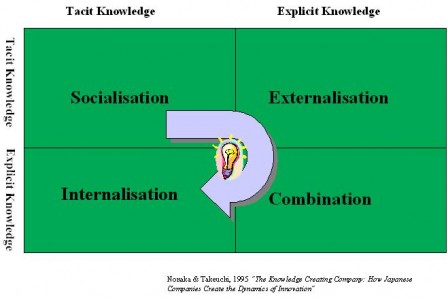At a presentation to a team of IT leaders back in 2011, I was asked what Web 2.0 and Knowledge Management (KM) had to do with my role as a Learning Technologist – and the answer is of course, it has EVERYTHING to do with learning! Our role as learning professionals is surely to enable our people to have access to the knowledge and tools they need to do their job. Personally, if that makes me a digital publishing company or a provider of Electronic Performance Support systems then it doesn’t actually matter as long as the end result is an engaged and productive workforce. Consider the following 2 definitions:
“A Community of practice is a community of people who care about the domain, thus creating the social fabric for learning, sharing, inquiry & trust.”
Source: Wenger, McDermott, Snyder, Cultivating Communities of Practice, (Boston, Mass: Harvard Business School Press, 2002)
and
“A social network is a social structure made of nodes (which are generally individuals or organizations) that are tied by one or more specific types of interdependency, such as values, visions, ideas, financial exchange, friendship, sexual relationships, kinship, dislike, conflict or trade.”
Source: http://en.wikipedia.org/wiki/Social_graph
Not a lot of difference really – what these statements do highlight is that the success of what we used to call “Communities of Practice” and the newer “Social Networks” is all about like minded people being involved. We used to say in the eLearning world that “Content is King” – in the world of informal learning, the King is dead and there is a now a new King on the block called “Context”!
But where does Knowledge management fit into all of this? Some of you will believe that KM is the domain of the IT Community. Others will think of it as being owned within the Corporate Communications team. But the reality is that ensuring there is a culture that encourages the free sharing of knowledge is a People problem – IT systems are simply enablers.
Those of you that have read Nonaka & Takeuchi’s 1995 work “The Knowledge Creating Company: How Japanese Companies Create the Dynamics of Innovation” will be familiar with the “Knowledge Spiral”. The challenge here is to capture Tacit Knowledge and move this around the organization, enhancing and improving at as it matures and creating new knowledge from the combination of what we know now with new information from outside of the organization. Many of the tools that are frowned upon in some organization can actually be of real benefit here, especially when looking to add to what we know from new and often external sources.

The Knowledge Spiral - Nonaka & Takeuchi
The sharing of tacit knowledge does of course happen – often known as the “water cooler culture” and of course, Web 2.0 brings a new dimension to this with sites such as Twitter being used very effectively for sharing knowledge – and now, not just 1-1 but 1-many. For those of you who work in the Learning & Development world, the weekly LRNCHAT on Twitter is an absolute wealth of useful information!
If we map some of these tools onto the Nonaka model, we can see that the technology really can enable a knowledge sharing culture:

(TLN Communities are internal Communities at L&G – this could equally be a Yammer Community for example).
At the heart of this though are the communities or social networks – and if you hire me, you hire my network at no extra cost!
At Legal & General, we implemented an LMS that included Community features and this gave us an advantage in that the LMS can provide the context that is vital for communities to thrive! Most of our communities were in fact formed without any corporate-led initiatives and were the result of staff seeing what others had done and understanding the art of the possible. The video on “Wikis in plain English” from www.commoncraft.comhas been widely used to show how you can use a Wiki for more than just an on-line encyclopaedia!
It was the use of communities for distributing meeting agendas and managing meeting minutes that fired up many of the newer groups. One group in particular decided to use a Wiki instead of email for gaining sign-off on critical documents. Instead of the process taking a week as the emails went around, they have achieved sign-off in ½ day!
Of course, not all communities will thrive – and some will have a natural lifespan as either the people or the topic moves on. One example we found was a community called “Blue Sky Thinkers” – you might be tempted to think that was a great idea to have a community especially for people who want to be innovative. Sadly, that wasn’t the case! The community was setup and nobody came. This was further proof for me that if there is no context for a discussion to take place then it won’t! Context really does make a community work.
But context in isolation isn’t all you need – here’s an interesting thought from Harold Jarche and http://connectedworkplace.co.uk/
The basic skills ALLworkers will need are:
- Personal knowledge management skills so that they can make sense of, and learn from, the constant stream of information that they encounter from social channels both inside and outside the organisation.
- Collaboration skills so that they can share their knowledge as well as work and learn productively and purposefully in teams, communities of practice, and social networks.
For more of Harold’s thoughts on PKM (Personal Knowledge Management), do check out http://www.jarche.com/pkm/ – to whet your appetite, here’s a brief introduction video:
But this isn’t just about enabling our people – every night, all of our tacit knowledge walks out of the door and we hope that it all comes back the next day! In these days of rightsizing and outsourcing, that isn’t always the case though. Add to that natural turnover and retirements, and this could mean that over the next 5 years, some 50% of the current implicit knowledge held by our people walks out of the door and doesn’t come back. Ever.
(based on HR data at a major Financial Services organisation)
It doesn’t have to be this way though!
If we get the culture right and encourage our people to share what they know, we can capture more of this knowledge whilst they are still here.
– Blogs, Wiki’s, discussion forums
If we implement a culture of trusting our people with the Web 2.0 tools such as Twitter, Blogs and Facebook, we may still have access to them after they have gone.
– My LinkedIn.com contact list contains a large number of current and former colleagues. (and I suspect, some future ones too!)
.– Make some of our eLearning Public Domain – if the Defence Acquisition University can do it, so can we! If we expect to receive then we must be prepared to give. (DAU content is on Itunes)
.
In summary, I can’t put it all much better than this quote, attributed to Al Gore:
“Our challenge is to process data into information, refine information into knowledge, extract from knowledge understanding, and then let understanding ferment into wisdom”.
And now, we have “Big Data” to add into the mix! It seems you can’t go anywhere these days without reference to “Big Data” – but what is it? I am indebted to Michael Hay, Vice President of Product Planning at Hitachi Data Systems and Chief Engineer at the Information Technology Platform Division (ITPD), for this definition:
“Big Data of the Future will become at scale agile processes realized by multidiscipline teams leveraging a variety of data categories and types flowed through various technologies, including provisions for security and privacy. The end result – timely discovery of sparks of insights leading to valuable innovation and knowledge.”
And that timely discovery is exactly what we are looking to achieve with the sharing of information and data. But of course, data analysis isn’t new! What is perhaps new for many is the variety of data types & sources that are now in the mix – you can see from the different sources of information shown in the diagram above that we have not only text but the social media elements such as video & audio in vast volumes from external sites to make sense of as well.
Of course, technology to assist in knowledge sharing isn’t new and organisations will already be looking to deploy such tools. So, who is best placed to create the context, which to me, is fundamental to the success of any collaboration or Knowledge sharing programme? The answer to that lies in understanding the sort of communities that would add value to our people such as:
- People with the same job – sharing success and ideas across locations & borders
- People with the same competency requirement – helping each other to achieve competence quicker
- People in the same location – adding the social aspect by way of location specific knowledge sharing
- People attending the same training event – adding value to existing classroom activities by including collaboration outside of the classroom, changing learning from an event to a process. (very successful in the UK with the Open University)
- Communities that are created dynamically based on these and other criteria – you don’t have to look for the group, the group finds you!
I don’t believe that this can be as effectively done outside of the HCM space as the source of the data to support this sort of dynamic environment exists in one place – your Human Capital “eco-system” of LMS, HRMS, Talent & Performance systems.
At a recent industry conference, Thomas Otter, formerly Research Director for Human Capital Management at Gartner, suggested that we should “Work on your strategy for social software in HCM and Learning now.“ I have to agree fully with this viewpoint to avoid being second in the race behind IT and/or Corporate Communications!
If this truly is a “People Problem”, then it requires “People Solutions” to fix it!
(Excerpts from this article have been used in earlier blog posts but having had a discussion last week with a colleague around the Knowledge Spiral, I thought the entire article was worth an airing! And since writing this, “Big Data” has become a buzzword and has been included)
